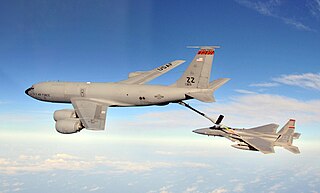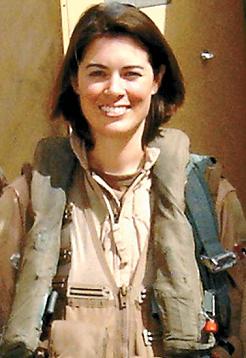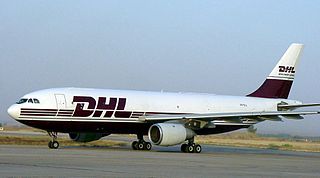
The Boeing KC-135 Stratotanker is an American military aerial refueling tanker aircraft that was developed from the Boeing 367-80 prototype, alongside the Boeing 707 airliner. It has a narrower fuselage and is shorter than the 707. Boeing gave the aircraft the internal designation of Model 717. The KC-135 was the United States Air Force (USAF)'s first jet-powered refueling tanker and replaced the KC-97 Stratofreighter. The KC-135 was initially tasked with refueling strategic bombers, but it was used extensively in the Vietnam War and later conflicts such as Operation Desert Storm to extend the range and endurance of US tactical fighters and bombers.

Aerial refueling, also referred to as air refueling, in-flight refueling (IFR), air-to-air refueling (AAR), and tanking, is the process of transferring aviation fuel from one aircraft to another while both aircraft are in flight. The two main refueling systems are probe-and-drogue, which is simpler to adapt to existing aircraft, and the flying boom, which offers faster fuel transfer, but requires a dedicated boom operator station.

Eileen Marie Collins is a retired NASA astronaut and United States Air Force (USAF) colonel. A former flight instructor and test pilot, Collins was the first woman to pilot the Space Shuttle and the first to command a Space Shuttle mission.

The Distinguished Flying Cross (DFC) is a military decoration of the United States Armed Forces. The medal was established on July 2, 1926, and is currently awarded to any persons who, after April 6, 1917, distinguish themselves by single acts of heroism or extraordinary achievement while participating in aerial flight. Both heroism and extraordinary achievement are entirely distinctive, involving operations that are not routine. The medal may be awarded to friendly foreign military members in ranks equivalent to U.S. Pay Grade of O-6 and below, in actual combat in support operations.

The Northrop T-38 Talon is a two-seat, twinjet supersonic jet trainer designed and produced by the American aircraft manufacturer Northrop Corporation. It was the world's first supersonic trainer as well as the most produced.

The Air Force Reserve Officers' Training Corps (AFROTC) is one of the three primary commissioning sources for officers in the United States Air Force and United States Space Force, the other two being the United States Air Force Academy (USAFA) and Air Force Officer Training School (OTS). A subordinate command of the Air University within the Air Education and Training Command (AETC), AFROTC is aligned under the Jeanne M. Holm Center for Officer Accessions and Citizen Development at Maxwell AFB, Alabama. The Holm Center, formerly known as the Air Force Officer Accession and Training Schools (AFOATS), retains direct responsibility for both AFROTC and OTS.

The Air Education and Training Command (AETC) is one of the nine Major Commands (MAJCOM) of the United States Air Force (USAF), reporting to Headquarters, United States Air Force. It was established 1 July 1993, with the realignment of Air Training Command and Air University.

Nicole Margaret Ellingwood Malachowski is a retired United States Air Force (USAF) officer and the first female pilot selected to fly as part of the USAF Air Demonstration Squadron, better known as the Thunderbirds. She later became a speaker and advocate on behalf of patients with tick-borne illnesses.

Brigadier General James Robinson "Robbie" Risner was a fighter pilot in the United States Air Force, and a senior leader among U.S. prisoners of war during the Vietnam War.

A fighter pilot or combat pilot is a military aviator trained to engage in air-to-air combat, air-to-ground combat and sometimes electronic warfare while in the cockpit of a fighter aircraft. Fighter pilots undergo specialized training in aerial warfare and dogfighting. A fighter pilot with at least five air-to-air kills becomes known as an ace.

Eugene Peyton Deatrick Jr. was a United States Air Force colonel, test pilot, and combat veteran. He is best recognized for his role in the rescue of United States Navy Lieutenant Dieter Dengler during the Vietnam War. The rescue was recounted in the Werner Herzog films Little Dieter Needs to Fly and Rescue Dawn and the national bestseller Hero Found: The Greatest POW Escape of the Vietnam War by author Bruce Henderson.

On 22 November 2003, shortly after takeoff from Baghdad, Iraq, an Airbus A300B2-200F cargo plane, registered OO-DLL and owned by the Belgian division of European Air Transport, was struck on the left wing by a surface-to-air missile while on a scheduled flight to Muharraq, Bahrain. Severe wing damage resulted in a fire and complete loss of hydraulic flight control systems. Because outboard left wing fuel tank 1A was full at takeoff, no fuel-air vapour explosion occurred. Liquid jet fuel dropped away as 1A disintegrated. Inboard fuel tank 1 was pierced and leaking.

The 124th Fighter Wing is a unit of the Idaho Air National Guard, stationed at Gowen Field Air National Guard Base, Boise, Idaho. It operates the Fairchild Republic A-10 Thunderbolt II aircraft conducting close air support missions. If activated to federal service, the Wing is gained by the United States Air Force Air Combat Command.

The Fairchild Republic A-10 Thunderbolt II is a single-seat, twin-turbofan, straight-wing, subsonic attack aircraft developed by Fairchild Republic for the United States Air Force (USAF). In service since 1976, it is named for the Republic P-47 Thunderbolt, but is commonly referred to as the "Warthog" or simply "Hog". The A-10 was designed to provide close air support (CAS) to friendly ground troops by attacking armored vehicles, tanks, and other enemy ground forces; it is the only production-built aircraft designed solely for CAS to have served with the U.S. Air Force. Its secondary mission is to direct other aircraft in attacks on ground targets, a role called forward air controller-airborne; aircraft used primarily in this role are designated OA-10.

Civil Air Patrol (CAP) is a congressionally chartered, federally supported non-profit corporation that serves as the official civilian auxiliary of the United States Air Force (USAF). CAP is a volunteer organization with an aviation-minded membership that includes members from all backgrounds. The program is established as an organization by Title 10 of the United States Code and its purposes defined by Title 36.

The Package Q Airstrike was the largest airstrike of the Gulf War and the largest strike of F-16 Fighting Falcon fighter aircraft in military history. Many aircraft, including the F-117 Nighthawk, were used to attack targets in Baghdad, which was the most heavily defended area of Iraq. The same target was hit several times by F-117s, and the last package consisted of seventeen F-111F Aardvarks on the 19th day of the war.
During the 1991 Gulf War and subsequent operations in no-fly zones over Iraq, Coalition air forces faced the Iraqi Air Force (IQAF), the fourth largest air force in the world at the time. In the opening days of the war, many air-to-air engagements occurred, between Iraqi interceptors and a variety of different Coalition aircraft.
Hispanics in the United States Air Force can trace their tradition of service back to the United States Army Air Forces (USAAF), the military aviation arm of the United States Army during and immediately after World War II. The USAAF was the predecessor of the United States Air Force, which was formed as a separate branch of the military on September 18, 1947, under the National Security Act of 1947. In the U.S., the term Hispanic categorizes any citizen or resident of the United States, of any racial background, of any country, and of any religion, who has at least one ancestor from the people of Spain or is of non-Hispanic origin but has an ancestor from Mexico, Puerto Rico, Cuba, Central or South America, or some other Hispanic origin. The three largest Hispanic groups in the United States are the Mexican-Americans, Puerto Ricans, and Cubans. According to the U.S. Census Bureau the estimated Hispanic population of the United States is over 50 million, or 16% of the U.S. population, and Hispanics are the nation's largest ethnic minority. The 2010 U.S. census estimate of over 50 million Hispanics in the U.S. does not include the 3.9 million residents of Puerto Rico, thereby making the people of Hispanic origin the nation's largest ethnic or race minority as of July 1, 2005.

Steven M. Rainey is a test pilot and retired United States Air Force (USAF) officer. As of 2022, he is a test pilot for Stratolaunch Systems working on the Scaled Composites Stratolaunch aircraft. Previously, he was Lockheed Martin's chief F-22 test pilot, Boeing's lead F-22 test pilot, and commander of the USAF 411th Flight Test Squadron. He is noted for a number of achievements while flight testing the Lockheed Martin F-22 Raptor. He was the first USAF pilot to fly the aircraft, the first pilot to perform aerial refueling in the F-22, and the first pilot to fly cross-country in the Raptor.
Operation Samurra was an operation by the Iraqi Air Force (IQAF) during the Gulf War to decisively engage McDonnell Douglas F-15C Eagle fighters from the United States Air Force (USAF) using Mikoyan-Gurevich MiG-25 interceptors, and break the "wall" of F-15s that the Coalition had established along Iraq's border with Iran. It demonstrated the last true offensive operation of the IQAF before grounding their air assets in an attempt to preserve them for future use. Through careful planning and coordination, two MiG-25 jets successfully caught two USAF F-15 fighters, of the 53rd Tactical Fighter Squadron out of Al Kharj Air Base, off guard and engaged them in a dogfight. After several minutes of aerial maneuvering and several fired missiles, the Iraqi jets returned to Tammuz Air Base undamaged, and the F-15s returned to Saudi Arabia, albeit with one damaged.


















